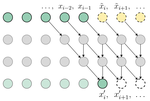Emiel Hoogeboom
PhD Student in Deep Learning
University of Amsterdam
Biography
My name is Emiel Hoogeboom and I am a PhD student at the University of Amsterdam under the supervision of Max Welling, in the UvA-Bosch Delta Lab.
Interests
- Generative Modelling
- Bayesian Inference
- Artificial Intelligence
Education
-
MSc in Artificial Intelligence, 2017
University of Amsterdam
-
BSc in Aerospace Engineering, 2015
Delft University of Technology













